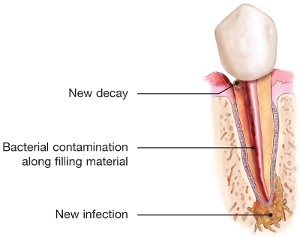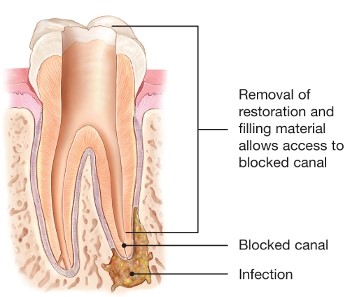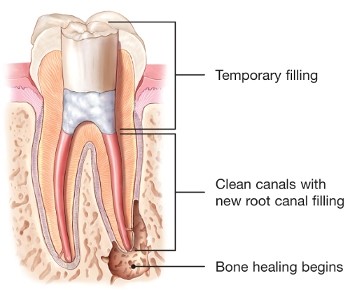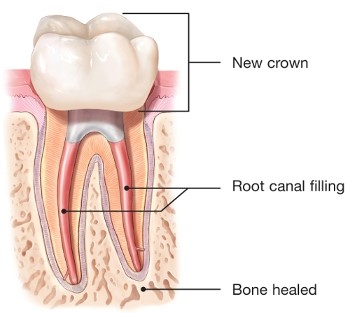Endodontic Retreatment (or Endodontic Revision) is a type of dental treatment needed when the initial root canal treatment was not successful by either unsatisfactory healing over time, presence of persistent symptoms, development of a new infection, or having the current treatment compromised.
Common reasons for unsuccessful treatment include inadequately cleaned canals, additional canal(s) that were not initially treated, new decay (caries) on the tooth that leads to reinfection by bacteria of the canals. Difficult anatomy of the canals may lead to inadequate cleaning or location of the canals. Examples of difficult anatomy include very narrow (calcified) canals, curved roots, and branching canals.











An endodontist has gone through extra training, past dental school, to acquire advanced knowledge and skills needed to treat difficult anatomy. Endodontists are trained to use advanced technologies such as operating microscopes, 3D imaging, and ultrasonic instruments. A board-certified endodontist represents an individual who has undergone 3 separate, rigorous examinations to achieve the pinnacle of their profession. This a feat that only around 20% of endodontists have achieved. Keep this in mind when selecting who will provide your endodontic care.
Thorough diagnostic testing and x-ray (radiographic) imaging will be completed to ensure an endodontic problem exists and if it’s the tooth with previous root canal treatment. Additionally, Cone Beam CT 3D imaging may be recommended to help identify the cause of failure. The prognosis and description of endodontic retreatment will then be explained to you.
Endodontic retreatment begins with numbing (anesthetizing) the tooth to ensure a comfortable and pain free appointment. Then a protective shield (dental dam) is placed over the tooth to be retreated to provide isolation and maintain a clean environment. Next, an opening (access) is made through the top (crown) of tooth. This includes any types of restorations, such as a crown, that may be present. Care is taken to help prevent damage to any type of restoration on the tooth.
The previously treated canals are located. All the current materials placed in the canals (root fillings, posts, etc) will be removed. At this time, any additional canals are located. Next, the length of each canal is carefully determined. The canals are then treated using small instruments of various sizes and fluid irrigation to meticulously disinfect, clean, and shape them. If previously treated canals were not cleaned to their full length, every attempt will be made to do so.
Saving your natural tooth is an excellent decision, since nothing looks, feels, or functions like your natural tooth.
Endodontic Retreatment
After properly and thoroughly cleaning and shaping the canals, they are then dried and filled to their full length. The root filling (gutta-percha) is a safe and soft material that can adapt to the shape of the canals to provide a 3-dimensional seal.
The tooth will then receive a temporary filling (restoration), which will be removed by your referring dentist. Even if no damage occurred to the existing restoration during retreatment, you will still need some type of final restoration to repair the opening (access) made and help seal the tooth. Your dentist will determine which type of final restoration is best for you. It is very important to go back to your dentist to receive this restoration in order to strengthen and seal the tooth, and help ensure the best possible success for your root canal treatment.
